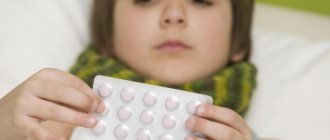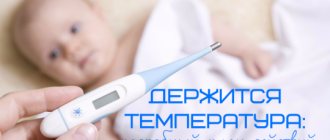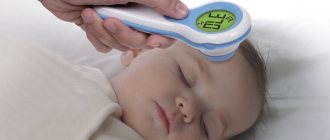Every adult knows that normal body temperature is 36.6 degrees. Any deviations in the direction of decreasing or increasing temperature conditions indicate the appearance of pathological processes in the body, which must be subjected to appropriate therapy as soon as possible. In a newborn baby, body temperature conditions may vary, because the baby’s body is not yet accustomed to factors that are unusual for it, so it reacts to any discomfort accordingly. Parents should take the necessary measures in a timely manner if the child’s temperature “deviates” from the norm. What temperature should a baby have at 2 months? What factors can influence the cause of a decrease or increase in temperature conditions?
Body temperature in infants
In a newborn baby, body temperature may change, but the scale of changes should not be too high or too low. Maintaining stable regimes directly depends on various factors. In infants, the thermoregulation system is not established, so the child’s body clearly reacts to changes occurring around it (air fluctuations, weather outside or the atmosphere in the house). Pediatricians are confident that the normal temperature of a two-month-old child may not meet the standards (36.6 degrees), since the baby’s body is not yet able to maintain stable conditions, so the child often overheats or, conversely, becomes hypothermic.
There are special tables that determine what normal body temperature a baby can have. Such graphs indicate average values, but it is important to remember that each person’s body is individual, therefore the norms for the corresponding regimes in children may be different.
It is important for parents to always monitor the behavior and well-being of the baby; they need to know what body temperature is optimal for the child. An elevated body temperature in a child does not always indicate overheating of the body (as a result of wrapping); often a change in the body patterns of a 2-month-old child is a sign of a respiratory or infectious disease.
What temperature is considered normal? A baby who was born healthy (Apgar scores range from 5 to 10) should have a body temperature between 37 and 37.2 degrees.
When to take your temperature
There is no need to measure the body temperature of children under one year old without any reason. This is stressful for them. But the procedure will be necessary if alarming symptoms appear:
- Excessive anxiety, lethargy, moodiness.
- Increased need for fluid.
- Dry mouth and lips are observed.
- Pulse and breathing become frequent and intermittent.
- The cheeks become very red or, on the contrary, pale.
- Chills appear, blurred vision.
A child under one year old requires increased attention from adults. Any failure to comply with hygiene standards can lead to a malfunction of the body. This causes the occurrence of various diseases.
Features of measuring baby's body temperature
In medical practice, there are 3 correct methods for correctly measuring temperature conditions:
- Oral – a thermometer is placed under the tongue of newborns.
- Rectally - the thermometer is carefully inserted into the baby's anus.
- In the armpits - the thermometer is carefully applied to the child’s armpits and clamped with a handle.
Of all the above methods of measuring temperature conditions, doctors do not single out any specific one. You can measure a child’s temperature in a variety of ways, but it is important to understand that the final readings will vary significantly.
The following indicators are considered the norm:
- When measured orally, the baby’s temperature is considered normal if it corresponds to 36.6 – 37.2 degrees.
- When measuring rectally in an infant, the norm will be readings corresponding to 36.9 – 37.4 degrees.
- When measuring temperature conditions in the armpits of newborns, the norm was determined to be 36 – 37.2 degrees.
Indications for thermometry
Thus, being a very dependent value, thermometry readings are very conditional and cannot be the main criterion for assessing the health status of a child or adult. Indications for thermometry in a child should include the following symptoms:
- deterioration of general condition;
- the appearance of weakness, malaise, apathy;
- lack of appetite;
- presence of facial hyperemia, sweating;
- hot skin when palpated;
- sharp pallor of the skin with a marble pattern;
- hands and feet cold to the touch;
- chills.
How to correctly measure the body temperature of a newborn?
Most often, parents prefer to measure their child’s body temperature in the armpits. To get the right result, you must follow important rules:
- The child should be calm when measuring the relevant indicators.
- The ideal time to measure is when your baby is fast asleep.
- It is important to remember that the normal temperature of a baby can vary depending on the influence of external factors. For example, if a newborn is frozen, then, accordingly, the final results of his temperature conditions will be underestimated. Conversely, if the baby is wrapped too warmly, then parents should not be surprised if the corresponding indicators become overestimated.
- The ideal position for measuring body temperature is the baby lies on its side, the thermometer is between the handle and the body.
- How long should you keep the thermometer? Depending on the type of thermometer, the duration of contact with the body may vary. Using a regular mercury thermometer, the temperature must be measured for at least 5 minutes.
37.4 lasts more than a week
If the readings change from time to time, this is either measurement errors or evidence of overheating. You should monitor the baby and record his changes in behavior and condition. If it is active, then no treatment is needed. When low-grade fever persists for more than a week, there is no need to rush into taking antipyretics.
Proceed as follows:
Additional Information. After vaccination, the increase in temperature is not accidental - this is how the body fights and produces antibodies to the injected pathogen. Giving an antipyretic should be considered carefully, since the vaccine sometimes causes hypothermia, and Ibuprofen or Paracetamol only worsens the situation.
If subfebrile values persist for a long period, this may indicate the presence of anemia, helminthic infestation, and brain diseases. A thorough medical examination will provide an accurate diagnosis. If no problems are identified, you should definitely start strengthening the baby’s immunity: start to harden yourself, take regular walks, regulate your diet, sleep and wakefulness.
You should measure your baby's temperature only when he is calm. And it is important for parents to be completely calm, without showing their anxiety to their child. Even the smallest children feel their mother’s mood, adopt it and begin to be very capricious, cry and scream. You should not make any serious decisions on your own, so that rash treatment does not lead to irreversible consequences. It is better to identify the cause or seek help from a pediatrician, then the baby will soon be completely healthy, cheerful and smiling, which will please his parents.
Possible causes of fever
As we found out above, the temperature of a two-month-old child should be in the range from 36.6 to 37.4 degrees inclusive. These parameters do not indicate a painful condition of the baby, but it is important for parents to make sure that the newborn does not overheat and feels comfortable.
If a baby’s body temperature at 2 months becomes higher than the specified norm, then the reasons for such changes may be as follows:
- The child is wearing a tight diaper, or is wearing clothes that in no way correspond to the actual weather conditions.
- The normal temperature of a 2-month-old baby can rise sharply if he has been in the sun for a long time.
- The baby's drinking regime is disrupted. This is one of the main reasons why normal body temperature can change dramatically. If little fluid enters the baby's body, then his sweating functions poorly, which disrupts the process of natural cooling of the skin.
- Constipation in a 2-month-old baby can cause a change in temperature.
- Severe overexcitation, which is often caused by active games, prolonged crying, screaming or continuous laughter, can provoke an increase in the normal temperature for a two-month-old child.
- In some babies, teething begins quite early and already at 2 months of age the child’s gums may become swollen. Such discomfort in the body provokes an increase in temperature conditions.
All of the above reasons provoke an increase in temperature conditions to 37.7 degrees. If the baby is depressed and passive, then it is necessary to alleviate his physiological condition (take off warm clothes, give him boiled water to drink, etc.) In the case of teething, it is important to stabilize the baby’s general well-being. To eliminate discomfort during teething, you can use pain-relieving gels; they will not only relieve discomfort in the child’s mouth, but will also help the child’s temperature to become 37, that is, normal.
If a newborn's temperature reaches 38 degrees, this may be a sign of an infectious or cold disease. The following diseases of the newborn can provoke fever:
- infections - measles, mumps, rubella, etc.;
- respiratory processes (flu, acute respiratory infections, ARVI);
- intestinal infections;
- inflammatory process of the respiratory or urinary system;
- diseases of the central nervous system;
- hormonal imbalances;
- injury;
- tumor process.
What causes the temperature to rise
An increase in temperature is a consequence of some provoking factor. Children under 3 months of age should not lower their body temperature below 38.2 degrees. The thermoregulation process can be disrupted. But this is only if the baby feels relatively well. If convulsions appear, he becomes lethargic, or loses his appetite, you should consult a doctor.
The reason for the increase in temperature may be:
- Viral and bacterial infections. In this case, there will be other symptoms: cough, redness of the throat, runny nose.
- Stressful situations.
- Overheat. Long exposure to the sun, improper dressing.
- Active games or long crying.
- The cause may be teething.
- A high temperature may be the result of an intestinal infection or a cold.
- The temperature of children under one year of age may increase after vaccination.
In the event that an elevated body temperature persists for three days, if it reaches 39 degrees or higher and is not reduced by antipyretics, you should immediately seek medical help. When it’s hot, the body’s tissues stop receiving oxygen, and the defenses weaken, which is a very dangerous condition.
An ambulance should be called in cases where the following symptoms appear:
- A child under three months of age has a fever.
- The baby's temperature is above 38.5 degrees.
- Convulsions appeared.
- Tension in the cervical spine, it is impossible to bend the head forward.
- Breathing becomes noisy and frequent.
- The child constantly cries, while he is lethargic and apathetic.
- Refusal to eat.
- There is frequent vomiting and diarrhea.
- Problems with urination or urine color.
- The appearance of a rash on the skin.
- Presence of chronic diseases.
- Inability to reduce fever with antipyretics.
Before the doctor arrives, you should follow a few simple recommendations.
- The baby should be given as much fluid as possible.
- The children's room needs to be ventilated. The child should be moved to another place for this time.
- The light should be dim. No harsh sounds.
- You can apply compresses to your legs. The towel is moistened in water (about 20 degrees) and applied to the feet.
- You can't wrap up a child.
If children's body temperature decreases, but only slightly (up to 35 degrees) and they feel well, then there is no need to worry. Perhaps this is an individual characteristic of the body. If the value drops below 35, they speak of hypothermia. You should consult a doctor. He will order additional examinations. You will need to consult a pediatrician, endocrinologist, or immunologist.
Reasons for a decrease in body temperature in a child under one year of age:
- In children born prematurely.
- During sleep.
- Against the background of a long-term illness, the body’s defenses weaken.
- Vitamin deficiency, anemia.
- Hormonal imbalance.
- While taking antipyretic drugs.
- Malignant formations.
- Hypothermia.
- After severe poisoning.
If the decrease is associated with hypothermia, then the child should be warmed up (warm drink, warm clothes, you can apply a heating pad to the legs). It is important to harden and increase immunity.
First aid for a newborn with fever
Depending on certain factors, the temperature of a 2-month-old baby may change; the normal body regime for a baby at the appropriate age is 36.6 – 37.4 degrees. When body temperature rises even by 1 – 1.5 degrees, the newborn’s immunity becomes more active, which significantly increases the body’s resistance.
How to reduce the temperature of a newborn? In order not to harm the baby’s health, you should not reduce the fever thoughtlessly, that is, without medical intervention. Doctors assure that a child’s temperature of 38 degrees can be considered pathological, and it is not recommended to reduce the fever to the specified level.
What should parents do if their newborn has a fever? The first parental aid for a child with a fever is to call emergency medical help. In ancient times, fever was reduced using folk methods, but conducting “experiments” on children is dangerous. Only a doctor will be able to determine the real condition of a small patient and prescribe him the necessary medications. As a rule, doctors prescribe antipyretics, most often Paracetamol in the form of suppositories or syrup. Medicines should be given to children only in accordance with the age recommendations specified in the medication label.
Why does the temperature rise
If the readings rise above 37.5 degrees, this indicates the onset of the disease. Most often it can be ARVI, overheating, teething or flu.
The most popular causes of fever among infants are:
Note! To prevent your baby from overheating, you should not wrap or swaddle him; it is advisable to dress him according to the weather. It is important to provide all the conditions for a comfortable microclimate in the room to prevent the development of various ailments.
conclusions
To measure temperature, use the tips in this article to get the correct readings.
If your child is sick, you should consult a doctor.
Do not forget about the reasons why a child’s temperature at the age of two months can fluctuate and be inconsistent. Before measuring, it is worth removing all possible factors due to which the child’s body temperature may change. There is no need to neglect measuring temperature, and you should carefully monitor its changes, pay attention to when and why it may change. And at the first signs of illness you should consult a doctor .
Indicators of normal temperature in newborn children in the room
Install a wall thermometer in the nursery and make sure that the temperature is kept within 20 to 24 °C, and the normal temperature of the baby is from 36 to 38 °C.
If the norm is slightly exceeded, try wiping the child with a warm, damp sponge. Never wipe your child with alcohol-containing products - this can cause vasospasm! Offer your baby fluids more often and change underwear and bedding more often.
If these remedies do not help, use paracetamol-based medications for infants. Usually the active ingredient of drops, syrup, suppositories or solution is indicated on the packaging. Read the instructions carefully. There are products based on other components.
To find out if your child is comfortable, touch the back of the head. If he is cold, then you need to warm the baby. Don’t give up on a cotton hat; sometimes without it, a baby loses about 30% of its heat.











